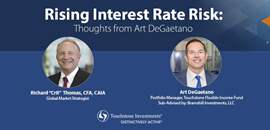- We are maintaining a neutral stance on large cap blend equities as market conditions appear more balanced. We believe steady positioning and selectivity are warranted.
- The 3Q earnings season was one of the strongest in years, with 82% of companies beating analyst estimates. Earnings are on track to rise 13% year over year, the fourth consecutive quarter of double-digit growth. 8 of 11 sectors reported EPS growth, and revenue growth was equally strong with every sector exceeding expectations.
- While most companies performed well, consumer goods lagged as lower income consumers showed more signs of financial strain. Consumption patterns are becoming K shaped, with upper income consumers sustaining spending and lower income households pulling back. Lower income consumers make up a larger percentage of the population, which helps explain the disconnect between very weak sentiment measures while data on consumer spending remains healthy (boosted by a smaller share of wealthy households).
- According to Bank of America, the top 40% of households by income (the upper leg of the K) hold nearly 85% of total wealth, with two-thirds tied to the stock market. This concentration implies consumer spending is increasingly sensitive to future market performance.
- For the lower leg, we believe employment is key. As long as consumers have jobs, they are likely to keep spending. We are watching layoff data closely as mass layoffs would push more people into the lower leg of the K and potentially signal slowing economic growth. Historically, layoffs tend to follow profit weakness as firms reduce staff to preserve margins. Given the recent strength in profits, rising layoff data stands somewhat at odds with history. Other factors, such as AI, may be having an impact.
- The Fed has restarted rate cuts. Historically, mid-cycle rate cuts have supported equities, but the key questions are how much of that optimism is already priced in and whether cuts will be as stimulative as expected. Notably, AI-driven investment, the current engine of growth, is largely unaffected by interest rates.
- By 2026, a more accommodative Fed, tax relief from the One Big Beautiful Bill, and tailwinds from the World Cup and 250th anniversary celebrations should all provide support for equities. These positive forces should help offset headwinds from tariffs and slowing labor force growth.

- We tactically hold a moderate underweight in Growth and remain neutral on Value.
- Our underweight in Growth reflects both elevated valuations and concentration risk, 5 stocks now account for about 45% of the Russell 1000 Growth Index. As Alpine Macro observes, “the overall market is held hostage to any idiosyncratic shock of a few mega companies.” These names are heavily tied to AI, making index performance dependent on that theme. Our positioning allows participation while managing risk exposure.
- The 3Q earnings season has been strong, given widespread revenue and earnings beats. The Russell 1000 Growth index is expected to post 21% earnings growth this year, roughly in line with the total return the Growth index has delivered to date. The Russell 1000 Value index, by contrast, is tracking towards 7% earnings growth and a total return of 13%, helped by multiple expansion.
- Despite strong returns, the Growth index overall does not appear to be in a bubble, as earnings broadly justify performance. Some AI-related stocks appear frothy, but the trend is not broad-based (yet). Unlike the dot.com boom, most publicly traded AI-related companies generate solid earnings and cash flow. However, some key drivers of AI investment, such as OpenAI, are privately held and are losing significant amounts of money.
- AI momentum remains strong, fueled by model advancements and capacity expansion to meet surging demand. Many firms reported bookings extending well into 2026 and beyond. The main growth constraint at this point is energy availability.
- We expect AI adoption to continue spreading rapidly, with benefits reaching far beyond the Technology sector, similar to the internet evolution. Sectors such as Financials and Industrials are among those most likely to benefit, given their repetitive, data rich, high volume, and rules based workflows.
- Looking ahead, Growth stocks continue to offer the greatest opportunity and risk, though today that risk is unusually concentrated. Value stocks, meanwhile, are more economically sensitive and could benefit if growth picks up next year. While we see this potential, meaningful headwinds temper our optimism.

- We favor mid caps over small caps, viewing them as offering the most attractive risk/reward balance in the current market.
- The 3Q earnings season was strong for both small and mid caps, though one would be hard pressed to see it in stock returns over the last month and a half. Nonetheless, year-to-date returns generally align with expected earnings for the year.
- The 3Q for small caps saw revenue growth of about 4% which was leveraged through margin expansion to 10% earnings growth versus a year ago. Earnings beats in the quarter were the strongest in four years, a positive sign given that the tariff impacts were more fully felt during the quarter. The Health Care and Technology sectors led earnings growth within small caps.
- Mid caps saw revenue growth of about 5% in the quarter, but limited margin expansion left earnings growth roughly in line with sales. Industrials, the index’s largest sector weight, faced cost pressures from tariffs. Meanwhile, homebuilders, brick-and-mortar retail, and restaurants faced weaker demand. The Financial and Health Care sectors were standouts, each posting over 20% earnings growth.
- Despite better results in the 3Q, small and mid cap earnings growth in the first half of the year has pulled down expected growth for the full year. At the start of this year, analysts expected mid cap earnings growth of 12% in 2025, but that forecast has fallen to just 1%. Similarly, small cap 2025 earnings growth expectations have declined from 17% to 5%. Much like large caps, earnings growth has been the primary return driver this year.
- Looking to 2026, hope again springs eternal for small and mid caps with earnings growth expectations of 17% and 18%, respectively. These forecasts seem like a stretch; fortunately, valuations suggest they aren’t being taken seriously. However, given earnings are still down from their 2022 peak, these forecasts may be achievable, aided by easier comparisons, looser monetary and fiscal policy, and what appears to be renewed M&A activity. We see reasons for optimism, but with weaker employment conditions, we prefer to be patient before adding exposure.

Equity Indexes Characteristics
The Indexes mentioned are unmanaged statistical composites of stock market or bond market performance. Investing in an index is not possible.



Glossary of Investment Terms and Index Definitions
Source: Bloomberg. Percent ranks are based on 30 years of monthly data as of the end of July; EPS growth estimates based on consensus bottom-up analyst estimates
The Touchstone Asset Allocation Committee
The Touchstone Asset Allocation Committee (TAAC) consisting of Crit Thomas, CFA, CAIA – Global Market Strategist, Erik M. Aarts, CIMA – Vice President and Senior Fixed Income Strategist, and Tim Paulin, CFA – Senior Vice President, Investment Research and Product Management, develops in-depth asset allocation guidance using established and evolving methodologies, inputs and analysis and communicates its methods, findings and guidance to stakeholders. TAAC uses different approaches in its development of Strategic Allocation and Tactical Allocation that are designed to add value for financial professionals and their clients. TAAC meets regularly to assess market conditions and conducts deep dive analyses on specific asset classes which are delivered via the Asset Allocation Summary document. Please contact your Touchstone representative or call 800.638.8194 for more information.
A Word About Risk
Investing in fixed-income securities which can experience reduced liquidity during certain market events, lose their value as interest rates rise and are subject to credit risk which is the risk of deterioration in the financial condition of an issuer and/or general economic conditions that can cause the issuer to not make timely payments of principal and interest also causing the securities to decline in value and an investor can lose principal. When interest rates rise, the price of debt securities generally falls. Longer term securities are generally more volatile. Investment grade debt securities which may be downgraded by a Nationally Recognized Statistical Rating Organization (NRSRO) to below
investment grade status. U.S. government agency securities which are neither issued nor guaranteed by the U.S. Treasury and are not guaranteed against price movements due to changing interest rates. Mortgage-backed securities and asset-backed securities are subject to the risks of prepayment, defaults, changing interest rates and at times, the financial condition of the issuer. Foreign securities carry the associated risks of economic and political instability, market liquidity, currency volatility and accounting standards that differ from those of U.S. markets and may offer less protection to investors. Emerging markets securities which are more likely to experience turmoil or rapid changes in market or economic conditions than developed countries.
Performance data quoted represents past performance, which is no guarantee of future results. The investment return and principal value of an investment in the Fund will fluctuate so that an investor’s shares, when redeemed, may be worth more or less than their original cost. Current performance may be higher or lower than performance data given. For performance information current to the most recent month-end, visit TouchstoneInvestments.com/mutual-funds.
Please consider the investment objectives, risks, charges and expenses of the fund carefully before investing. The prospectus and the summary prospectus contain this and other information about the Fund. To obtain a prospectus or a summary prospectus, contact your financial professional or download and/or request one on the resources section or call Touchstone at 800-638-8194. Please read the prospectus and/or summary prospectus carefully before investing.
Touchstone Funds are distributed by Touchstone Securities, Inc.*
*A registered broker-dealer and member FINRA/SIPC.
Touchstone is a member of Western & Southern Financial Group
Not FDIC Insured | No Bank Guarantee | May Lose Value


















